
The Gherkin, formally 30 St Mary Axe and previously known as the Swiss Re Building, is a commercial skyscraper in London's primary financial district, the City of London. It was completed in December 2003 and opened in April 2004. With 41 floors, it is 180 metres (591 ft) tall and stands on the sites of the former Baltic Exchange and Chamber of Shipping, which were extensively damaged in 1992 in the Baltic Exchange bombing by a device placed by the Provisional IRA in St Mary Axe, a narrow street leading north from Leadenhall Street.

Aldgate was a gate in the former defensive wall around the City of London. It gives its name to Aldgate High Street, the first stretch of the A11 road, which included the site of the former gate.

Threadneedle Street is a street in the City of London, England, between Bishopsgate at its northeast end and Bank junction in the southwest. It is one of nine streets that converge at Bank. It lies in the ward of Cornhill.
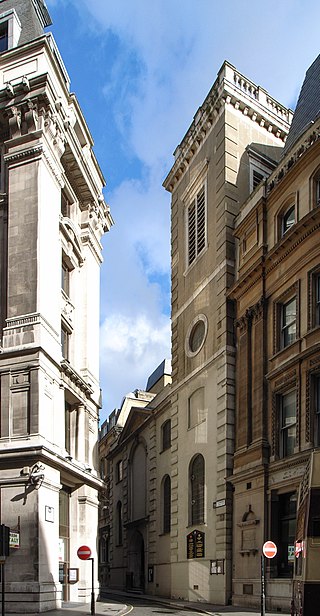
St Clement Eastcheap is a Church of England parish church in Candlewick Ward of the City of London. It is located on Clement's Lane, off King William Street and close to London Bridge and the River Thames.

Minories is the name of a small former administrative unit, and also of a street in central London. Both the street and the former administrative area take their name from the Abbey of the Minoresses of St. Clare without Aldgate.

The Lloyd's building is the home of the insurance institution Lloyd's of London. It is located on the former site of East India House in Lime Street, in London's main financial district, the City of London. The building is a leading example of radical Bowellism architecture in which the services for the building, such as ducts and lifts, are located on the exterior to maximise space in the interior.

St Helen's is a commercial skyscraper in London, United Kingdom. It is 118 metres (387 ft) tall and has 23 floors. The postal address is No. 1, Undershaft, though the main entrance fronts onto Leadenhall Street, in the City of London financial district.

St Andrew Undershaft is a Church of England church in the City of London, the historic nucleus and modern financial centre of London. It is located on St Mary Axe, within the Aldgate ward, and is a rare example of a City church that survived both the Great Fire of London and the Blitz.

The Guild Church of St Katharine Cree is an Anglican church in the Aldgate ward of the City of London, on the north side of Leadenhall Street near Leadenhall Market. It was founded in 1280. The present building dates from 1628 to 1630. Formerly a parish church, it is now a guild church.

The Baltic Exchange is a membership organisation for the maritime industry, and freight market information provider for the trading and settlement of physical and derivative contracts.

122 Leadenhall Street, which is also known as the Leadenhall Building, is a 225-metre-tall (738 ft) skyscraper in central London. It opened in July 2014 and was designed by the Rogers Stirk Harbour + Partners; it is known informally as The Cheesegrater because of its distinctive wedge shape similar to that of the kitchen utensil with the same name. It is one of numerous tall buildings recently completed or under construction in the City of London financial district, including 20 Fenchurch Street, 22 Bishopsgate and The Scalpel.
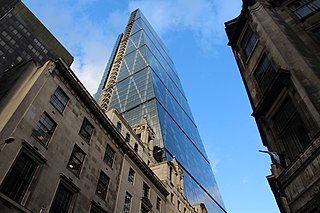
Leadenhall Street is a street in the City of London. It is about 1⁄3-mile-long (0.54 km) and links Cornhill in the west to Aldgate in the east. It was formerly the start of the A11 road from London to Norwich, but that route now starts further east at Aldgate.
St Mary Axe was a mediaeval church in the City of London. Its full name was St Mary, St Ursula and her 11,000 Virgins, and it was also sometimes referred to as St Mary Pellipar. Its common name derives from the sign of an axe over the east end of the church. The church's patrons were the Skinners' Company.

Lime Street is a minor road in the City of London between Fenchurch Street to the south and Leadenhall Street to the north. Its name comes from the lime burners who once sold lime from there for use in construction.
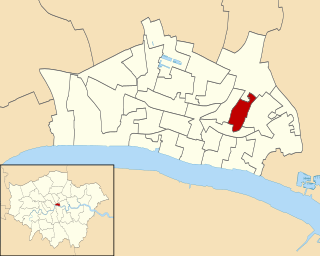
Lime Street is one of the 25 ancient wards of the City of London.
It is divided into four precincts; and it is worthy a remark that, though the ward includes parts of several parishes, there is not even a whole street in it.
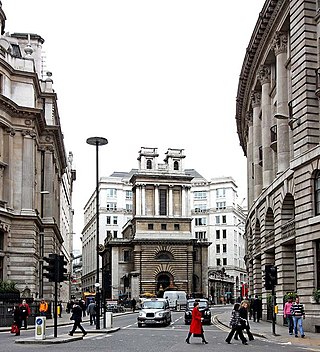
Lombard Street is a street notable for its connections with the City of London's merchant, banking and insurance industries, stretching back to medieval times.

Mark Lane is a street in the City of London linking Great Tower Street and Fenchurch Street. It gave its name to the nearby Mark Lane tube station, which was opened in 1884, renamed Tower Hill in 1964, and closed three years later. For some 240 years, Mark Lane was known for the corn exchange ; it occupied a series of properties on the east side of the southern end of the street.
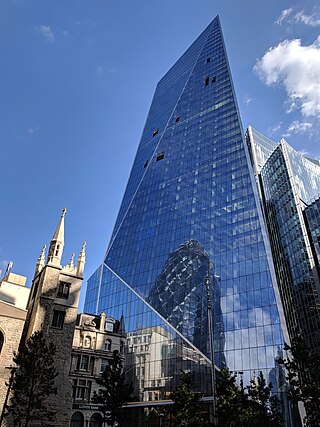
The Scalpel is a commercial skyscraper in London, United Kingdom. It is located on Lime Street in the City of London financial area. Originally a nickname but subsequently designated as its official name, the term "Scalpel" was coined by the Financial Times due to the building's distinctive angular design. The building has also been noted for its similarity to a "play" media button due to how it looks from South of the River Thames. This follows a trend of nicknaming new buildings based upon their shape, such as the nearby Leadenhall Building, also known as "The Cheesegrater". Completed in 2018, The Scalpel at 52 Lime Street is 190 m (620 ft) tall, with 38 storeys. It was designed by Kohn Pedersen Fox.
The Baltic Exchange bombing was an attack by the Provisional IRA on the City of London, Britain's financial centre, on 10 April 1992, the day after the General Election which re-elected John Major from the Conservative Party as Prime Minister. The one-ton bomb – concealed in a van and consisting of a fertilizer device wrapped with a detonation cord made from 100 lb (45 kg) of semtex – was the biggest bomb detonated on mainland Britain since World War II. The bombing killed three people, injured 91 others, and severely damaged the Baltic Exchange and its surroundings.

70 St Mary Axe, informally known as the Can of Ham due to its shape, is an office building in the City of London. It was completed in early 2019. With 21 floors above ground, it is 90 metres (295 ft) tall and offers 28,000 square metres (301,400 sq ft) of office space. During its construction, the City of London Corporation decided to pedestrianise the part of St Mary Axe along which the building sits, between Bevis Marks to the south-west and Houndsditch to the north-east.


















